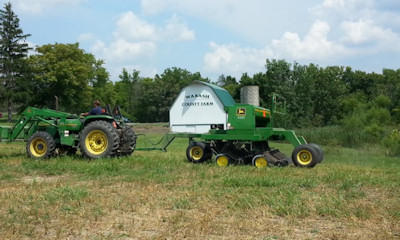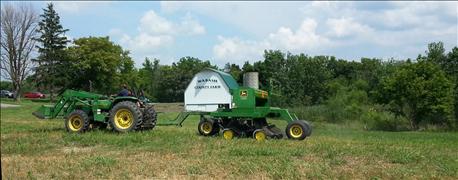February 28, 2016

In the mid-1850s Wabash County established a home for adults who were “poor, aged, or infirm, and children whose parents were either dead or unable to support them.” The home was on a farm, now at the southeast corner of US 24 and State Road 13.
The home was closed in 1974. In the 1990s the Wabash County Commissioners leased the farm’s 52 tillable acres to the Wabash County Soil and Water Conservation District. The SWCD began no-tilling and experimenting with cover crops.

NO-TILL AND COVER: Intensive research goes on at this working farm in Wabash County. (photo courtesy Wabash SWCD).
In 2012 Wabash County SWCD board member Bobby Hettmansperger was also a board member of the state conservation organization. He learned that the newly created Indiana Conservation Cropping Systems Initiative was looking for “hub farms” to do research. CCSI was interested in the Wabash site, partly because it was still a working farm. It was already in no-till and cover crops. The Wabash SWCD quickly approved the site becoming a hub farm.
As a hub farm Wabash SWCD annually does side-by-side strip trials in which various cover crops are incorporated into every other strip. Spring and fall soil testing is done. Biomass samples are forwarded to CCSI. Every other year samples are sent to additional laboratories.
Earnings from the farm fund production expenses and regular field days. This year’s late-summer field day will feature cover crops after wheat.
Upgrading the farm
In 2013 the district worked with county commissioners to upgrade or install a number of other conservation practices. Aging waterways were reconstructed and water and sediment control basins were installed, as well as a drainage water control structure.
The farm includes a pond and two wetlands. Together these features make a working demonstration area for an array of contemporary conservation practices.
The farm also includes woods. In 2008 the district hired college summer interns to help clean up, maintain and improve non-tillable acres. They mowed and cleaned up brush and fallen trees and began controlling invasive species.
Trails were created and mulched. Two footbridges were constructed.
Since then interns have continued maintaining and improving the property. In 2013 a professor from Manchester University identified and marked 36 species of trees.
The result is an attractive and informative nature and historical trail system. It’s available to 4-H, FFA, school groups and others for events.
Rob Shellhamer, chairman of the Wabash County SWCD supervisors, says the district is fortunate to have such a unique resource.
“We really appreciate the commissioners allowing us to use the farm,” he said. “It’s been very helpful in our work to advance the use of conservation practices. It’s in a very visible location here between 13 and 24, and we like to think it’s helping us lead by example. But it’s also been good to see the farm continue to be used for what it was originally intended - providing good and needed services for the people of Wabash County.”
- Darrell Boone writes from Wabash.
You May Also Like




